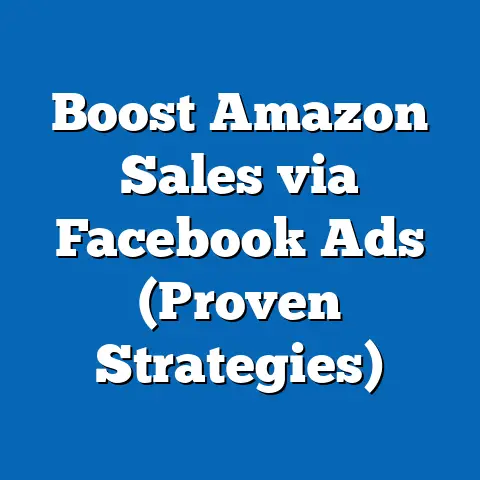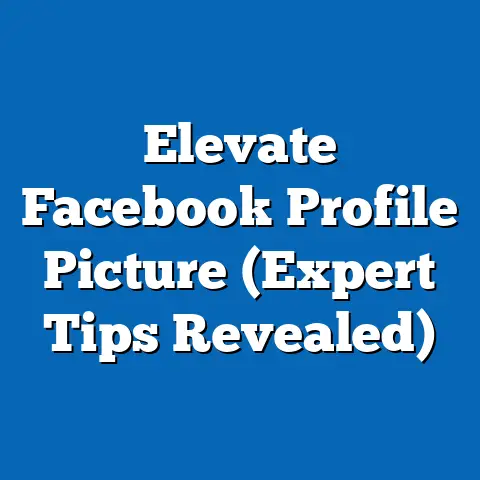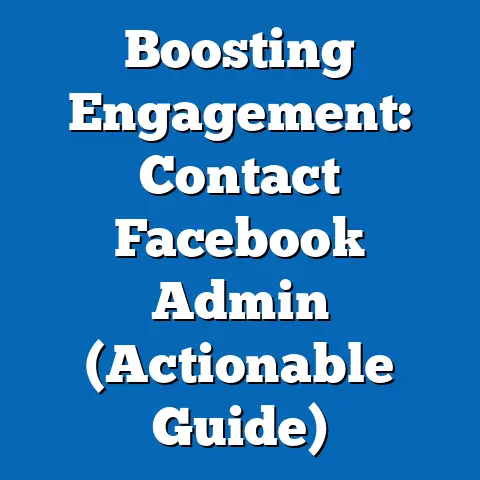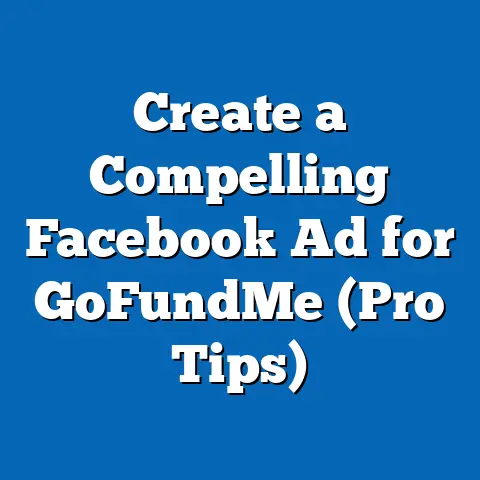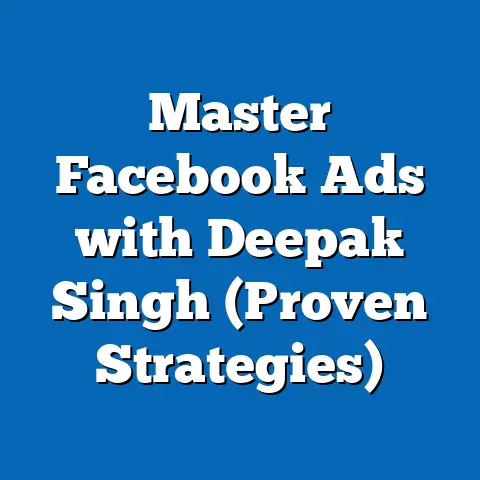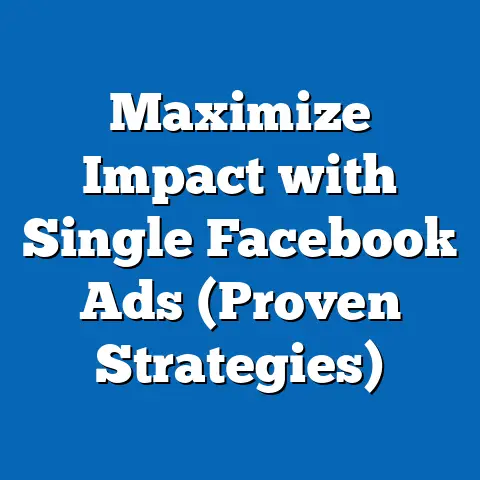Mastering Facebook Ads for Success (Proven Strategies Revealed)
In today’s digital age, where attention spans are shorter than ever and the competition for eyeballs is fiercer, mastering the art of online advertising is no longer a luxury but a necessity for businesses of all sizes. And when it comes to online advertising, Facebook ads remain a powerhouse. With billions of active users, granular targeting options, and a diverse range of ad formats, Facebook provides an unparalleled platform for reaching your ideal customers.
I’ve spent years immersed in the world of Facebook advertising, managing campaigns for businesses across various industries and budgets. I’ve seen firsthand what works, what doesn’t, and the common pitfalls that can derail even the most promising campaigns. In this article, I’ll share my hard-earned knowledge and insights, along with expert picks from leading digital marketers, to help you master Facebook ads and achieve your business goals.
Think of this as your ultimate playbook for Facebook advertising success. We’ll cover everything from the fundamentals of Facebook ads and target audience identification to advanced strategies like retargeting and leveraging user-generated content. We’ll also dive into real-world case studies and success stories to illustrate the power of effective Facebook advertising.
So, whether you’re a seasoned marketer looking to refine your Facebook ad strategy or a complete beginner eager to get started, this guide has something for you. Let’s embark on this journey together and unlock the full potential of Facebook ads for your business.
Section 1: Understanding Facebook Ads
Before we dive into the nitty-gritty details of creating and optimizing Facebook ads, it’s essential to have a solid understanding of what Facebook ads are and why they’re so important in the digital marketing landscape.
What are Facebook Ads?
Facebook ads are paid advertisements that appear on the Facebook platform, including the Facebook News Feed, right column, Instagram, Messenger, and Audience Network. These ads can take various forms, including:
- Image Ads: Simple ads featuring a single image and accompanying text.
- Video Ads: Ads that use video to capture attention and convey a message.
- Carousel Ads: Ads that display multiple images or videos in a scrolling format.
- Collection Ads: Ads that showcase products in a visually appealing and immersive format.
- Instant Experience Ads: Full-screen, mobile-optimized ads that provide an engaging and interactive experience.
- Lead Ads: Ads designed to collect leads directly within the Facebook platform.
- Messenger Ads: Ads that appear in the Facebook Messenger app.
- Dynamic Ads: Ads that automatically promote products to people who have expressed interest on your website, in your app, or elsewhere on the internet.
Each ad type serves a different purpose and can be tailored to specific marketing objectives. For example, image ads are great for generating brand awareness, while lead ads are ideal for capturing contact information from potential customers.
The Importance of Facebook Ads in Digital Marketing
Facebook ads have become an indispensable tool for digital marketers, and for good reason. Here are some compelling statistics that highlight the effectiveness of Facebook ads:
- Reach: Facebook boasts over 2.9 billion monthly active users, making it the largest social media platform in the world. This massive reach provides businesses with an unparalleled opportunity to connect with their target audience.
- Targeting: Facebook’s robust targeting options allow advertisers to reach specific demographics, interests, behaviors, and even custom audiences based on their own customer data. This level of precision ensures that your ads are seen by the people most likely to be interested in your products or services.
- Cost-Effectiveness: Compared to other advertising channels, Facebook ads can be incredibly cost-effective, especially when you optimize your campaigns for specific objectives.
- Engagement: Facebook users are highly engaged, spending an average of 34 minutes per day on the platform. This high level of engagement provides advertisers with ample opportunities to capture attention and drive conversions.
- Measurability: Facebook’s Ads Manager provides detailed analytics and reporting, allowing advertisers to track their campaign performance and make data-driven decisions.
According to Statista, Facebook’s advertising revenue in 2023 was over $130 billion, demonstrating the platform’s continued dominance in the digital advertising landscape.
Moreover, Facebook’s unique features, such as its social sharing capabilities and its ability to integrate with other platforms like Instagram, make it an even more attractive option for advertisers.
Expert Picks on Facebook Ads
To further emphasize the importance of Facebook ads and provide you with valuable insights from leading digital marketers, I’ve compiled some expert picks on the topic:
- Neil Patel: “Facebook advertising is one of the most effective ways to reach your target audience online. With the right targeting and ad creative, you can generate high-quality leads and drive significant revenue for your business.”
- Mari Smith: “Facebook ads are a powerful tool for building brand awareness, driving website traffic, and generating leads. The key to success is to create compelling ad content that resonates with your target audience and to continuously test and optimize your campaigns.”
- Gary Vaynerchuk: “Facebook advertising is not just about selling products or services. It’s about building relationships with your customers and providing them with value. When you focus on providing value, the sales will follow.”
- Amy Porterfield: “Facebook ads are an essential part of any successful online marketing strategy. By leveraging Facebook’s targeting options and creating engaging ad content, you can reach your ideal customers and achieve your business goals.”
These expert opinions highlight the importance of Facebook ads in today’s digital marketing landscape and provide valuable insights into how to succeed with the platform.
Key Takeaway: Facebook ads are a powerful and cost-effective way to reach your target audience, build brand awareness, and drive conversions. By understanding the fundamentals of Facebook ads and leveraging expert insights, you can create successful campaigns that achieve your business goals.
Section 2: Crafting Effective Facebook Ads
Now that we’ve established the importance of Facebook ads, let’s dive into the specifics of crafting effective ads that capture attention, resonate with your target audience, and drive results.
Target Audience Identification
One of the most critical steps in creating successful Facebook ads is identifying your target audience. Without a clear understanding of who you’re trying to reach, your ads are likely to fall flat and waste your advertising budget.
Here are some techniques for audience research and segmentation:
- Analyze Your Existing Customer Data: Look at your existing customer base to identify common demographics, interests, and behaviors. This data can provide valuable insights into who your ideal customers are.
- Conduct Market Research: Conduct surveys, interviews, and focus groups to gather information about your target audience’s needs, preferences, and pain points.
- Use Facebook’s Audience Insights Tool: Facebook’s Audience Insights tool provides valuable data about the demographics, interests, and behaviors of people on Facebook. You can use this tool to identify potential target audiences for your ads.
- Create Customer Personas: Develop detailed customer personas that represent your ideal customers. These personas should include information about their demographics, interests, behaviors, motivations, and goals.
By conducting thorough audience research and segmentation, you can create highly targeted Facebook ads that resonate with your ideal customers and drive better results.
For example, if you’re selling organic baby food, your target audience might be parents aged 25-45 with young children, who are interested in healthy eating, natural products, and parenting. You can then use Facebook’s targeting options to reach this specific audience.
Creating Compelling Ad Content
Once you’ve identified your target audience, the next step is to create compelling ad content that captures their attention and resonates with their needs and interests.
Here are some tips for writing engaging ad copy:
- Know Your Audience: Write ad copy that speaks directly to your target audience’s needs, pain points, and aspirations.
- Highlight Benefits, Not Just Features: Focus on the benefits of your product or service, rather than just listing its features. Explain how your product or service will solve their problems or improve their lives.
- Use Strong Headlines: Your headline is the first thing people will see, so make it count. Use strong, attention-grabbing headlines that pique their interest and make them want to learn more.
- Keep it Concise: People have short attention spans, so keep your ad copy concise and to the point. Get your message across quickly and effectively.
- Include a Clear Call to Action: Tell people what you want them to do. Use a clear and compelling call to action that encourages them to click on your ad, visit your website, or make a purchase.
Storytelling can be a powerful tool for creating engaging ad content. By telling a story that resonates with your target audience, you can capture their attention and build a connection with your brand.
For example, instead of simply saying “Our organic baby food is healthy and nutritious,” you could tell a story about a parent who struggled to find healthy food options for their child and how your product helped them solve that problem.
Visual elements, such as images and videos, also play a crucial role in enhancing ad performance. High-quality images and videos can capture attention, convey your message more effectively, and increase engagement rates.
Designing Eye-Catching Ads
In addition to compelling ad copy, it’s also essential to design eye-catching ads that stand out from the crowd.
Here are some best practices for ad design:
- Use High-Quality Images and Videos: Use images and videos that are clear, visually appealing, and relevant to your product or service.
- Use a Consistent Brand Identity: Maintain a consistent brand identity across all of your ads, including your logo, color scheme, and typography.
- Use a Clear and Simple Layout: Keep your ad layout clean and uncluttered. Avoid overcrowding your ad with too much text or too many images.
- Use Contrasting Colors: Use contrasting colors to make your ad stand out from the background.
- Use a Strong Call to Action Button: Use a visually appealing call to action button that encourages people to click on your ad.
Key Takeaway: Crafting effective Facebook ads requires a deep understanding of your target audience, compelling ad content, and eye-catching design. By following these best practices, you can create ads that capture attention, resonate with your audience, and drive results.
Section 3: Setting Up and Launching Your Campaign
Now that you’ve crafted your compelling ad content and designed eye-catching visuals, it’s time to set up and launch your Facebook ad campaign. This section will walk you through the process step-by-step, ensuring you have a solid foundation for success.
Creating Your Ad Campaign
Facebook’s Ads Manager is your central hub for creating and managing your ad campaigns. Here’s a step-by-step guide on setting up your first campaign:
- Go to Facebook Ads Manager: Navigate to Ads Manager through your Facebook business page or by searching for “Facebook Ads Manager” in your browser.
- Click “Create”: This will initiate the campaign creation process.
- Choose Your Campaign Objective: Facebook offers various campaign objectives, each designed to achieve specific marketing goals. These include:
- Awareness: Increase brand awareness and reach a wider audience.
- Traffic: Drive traffic to your website or app.
- Engagement: Increase engagement with your Facebook page or posts.
- Leads: Collect leads from potential customers.
- App Promotion: Promote your mobile app.
- Sales: Drive online sales or conversions.
- Name Your Campaign: Give your campaign a descriptive name that reflects its objective and target audience.
- Set Your Budget: Choose between a daily budget or a lifetime budget. A daily budget sets the average amount you’re willing to spend each day, while a lifetime budget sets the total amount you’re willing to spend over the entire campaign duration.
- Define Your Target Audience: This is where you’ll leverage your audience research to target specific demographics, interests, behaviors, and connections. You can also create custom audiences based on your own customer data or website traffic.
- Choose Your Ad Placements: Select where you want your ads to appear, including Facebook News Feed, Instagram Feed, Audience Network, and Messenger.
- Create Your Ad: Choose your ad format (e.g., image ad, video ad, carousel ad) and upload your creative assets. Write your ad copy and include a clear call to action.
- Review and Publish: Double-check all your campaign settings and ad creative before publishing your campaign.
- Awareness: Increase brand awareness and reach a wider audience.
- Traffic: Drive traffic to your website or app.
- Engagement: Increase engagement with your Facebook page or posts.
- Leads: Collect leads from potential customers.
- App Promotion: Promote your mobile app.
- Sales: Drive online sales or conversions.
Budgeting and Bidding Strategies
Budgeting and bidding strategies play a crucial role in determining the success of your Facebook ad campaigns. Choosing the right options can help you maximize your reach and achieve your desired results while staying within your budget.
Here’s a breakdown of the different budgeting options:
- Daily Budget: Sets the average amount you’re willing to spend each day on your ad campaign. This option is ideal for campaigns that run continuously.
- Lifetime Budget: Sets the total amount you’re willing to spend over the entire duration of your ad campaign. This option is ideal for campaigns with a specific start and end date.
Facebook also offers various bidding strategies, including:
- Lowest Cost: Facebook automatically bids to get you the most results for your budget. This option is ideal for beginners or campaigns with limited budgets.
- Cost Per Result Goal: You set a target cost per result (e.g., cost per lead, cost per conversion), and Facebook automatically bids to achieve that goal. This option is ideal for campaigns with specific performance targets.
- Manual Bidding: You manually set your bids for each ad auction. This option is ideal for experienced advertisers who want more control over their bidding strategies.
Choosing the right bidding strategy depends on your campaign objectives, budget, and level of experience. For beginners, the “Lowest Cost” option is often a good starting point.
Ad Placement Options
Facebook offers a variety of ad placement options, each with its own advantages and disadvantages. The most common ad placements include:
- Facebook News Feed: Ads appear directly in users’ News Feeds, alongside posts from their friends and family. This is often the most effective ad placement for generating engagement and driving traffic.
- Instagram Feed: Ads appear in users’ Instagram Feeds, similar to Facebook News Feed. This placement is ideal for visually appealing ads targeting a younger audience.
- Facebook Right Column: Ads appear in the right column of the Facebook website. This placement is less intrusive than News Feed ads but may also have lower engagement rates.
- Facebook Marketplace: Ads appear within the Facebook Marketplace, a platform for buying and selling goods.
- Facebook Stories: Full-screen ads that appear between users’ Stories on Facebook and Instagram.
- Instagram Stories: Similar to Facebook Stories, but on Instagram.
- Audience Network: Ads appear on websites and apps outside of Facebook and Instagram. This placement can help you reach a wider audience but may have lower engagement rates.
- Messenger: Ads can appear in the Messenger inbox or as sponsored messages within conversations.
Choosing the best ad placements for your campaign depends on your target audience, ad format, and campaign objectives. It’s often a good idea to test different ad placements to see which ones perform best for your specific campaign.
Key Takeaway: Setting up and launching your Facebook ad campaign involves creating your campaign in Ads Manager, choosing the right budgeting and bidding strategies, and selecting the best ad placement options for your target audience and campaign objectives.
Section 4: Analyzing and Optimizing Your Ads
Once your Facebook ad campaign is up and running, the real work begins: analyzing your campaign performance and optimizing your ads for better results. This section will guide you through the process of understanding ad metrics, analyzing campaign performance, and optimizing your ads for maximum impact.
Understanding Ad Metrics
To effectively analyze your Facebook ad campaign performance, you need to understand the key performance indicators (KPIs) that provide insights into your ads’ effectiveness. Here are some of the most important ad metrics to track:
- Impressions: The number of times your ad was shown to users.
- Reach: The number of unique users who saw your ad.
- Click-Through Rate (CTR): The percentage of people who saw your ad and clicked on it. A higher CTR indicates that your ad is relevant and engaging to your target audience.
- Cost Per Click (CPC): The average cost you paid for each click on your ad. A lower CPC indicates that your ad is cost-effective.
- Conversion Rate: The percentage of people who clicked on your ad and completed a desired action, such as making a purchase or filling out a lead form. A higher conversion rate indicates that your ad is effective at driving conversions.
- Cost Per Acquisition (CPA): The average cost you paid for each conversion. A lower CPA indicates that your ad is cost-effective at driving conversions.
- Return on Ad Spend (ROAS): The amount of revenue you generated for every dollar you spent on advertising. A higher ROAS indicates that your ad is profitable.
A/B testing, also known as split testing, is a powerful technique for optimizing your Facebook ads. It involves creating multiple versions of your ad with different elements (e.g., headline, image, call to action) and testing them against each other to see which version performs best.
Analyzing Campaign Performance
Facebook’s Ads Manager provides a wealth of data and analytics that you can use to analyze your campaign performance. Here’s a detailed approach to analyzing your Facebook ads:
- Log into Ads Manager: Access your Ads Manager account and navigate to the campaign you want to analyze.
- Review Key Metrics: Examine the key metrics mentioned above (impressions, reach, CTR, CPC, conversion rate, CPA, ROAS) to get an overview of your campaign performance.
- Segment Your Data: Segment your data by different variables, such as demographics, interests, placements, and devices, to identify trends and patterns.
- Identify Underperforming Ads: Identify ads that are underperforming based on your chosen KPIs.
- Analyze Ad Creative: Analyze the ad creative (headline, image, copy, call to action) of your underperforming ads to identify potential areas for improvement.
- Compare Ad Performance: Compare the performance of different ads within your campaign to identify which ads are performing best.
- Draw Insights: Based on your analysis, draw insights about what’s working and what’s not working in your campaign.
For example, you might find that your ads targeting women aged 25-35 are performing well, while your ads targeting men aged 25-35 are underperforming. This insight could lead you to adjust your targeting or ad creative to better resonate with the male demographic.
Optimizing for Better Results
Based on your analysis of campaign performance, you can implement various optimization strategies to improve your Facebook ads’ results. Here are some strategies for optimizing underperforming ads:
- Improve Your Targeting: Refine your targeting to reach a more relevant audience.
- Update Your Ad Creative: Experiment with different headlines, images, ad copy, and calls to action to see what resonates best with your audience.
- Adjust Your Bidding Strategy: Adjust your bidding strategy to optimize for conversions or ROAS.
- Test Different Ad Placements: Test different ad placements to see which ones perform best for your specific campaign.
- Pause Underperforming Ads: Pause ads that are consistently underperforming to avoid wasting your advertising budget.
Scaling successful ad campaigns involves increasing your budget and expanding your reach while maintaining or improving your performance metrics. However, it’s important to scale gradually to avoid negatively impacting your campaign performance.
Key Takeaway: Analyzing and optimizing your Facebook ads is an ongoing process that involves understanding ad metrics, analyzing campaign performance, and implementing optimization strategies to improve your results.
Section 5: Advanced Facebook Ads Strategies
Once you’ve mastered the fundamentals of Facebook ads, you can start exploring more advanced strategies to further enhance your campaign performance and achieve your marketing goals. This section will introduce you to some of the most effective advanced Facebook ads strategies, including retargeting, utilizing Facebook Pixel, and leveraging user-generated content.
Retargeting Strategies
Retargeting is a powerful advertising technique that involves showing ads to people who have previously interacted with your brand or website. This can be incredibly effective because these users are already familiar with your brand and are more likely to convert.
Here’s how retargeting works:
- Install Facebook Pixel: Install the Facebook Pixel on your website to track user behavior.
- Create Custom Audiences: Create custom audiences based on specific actions users have taken on your website, such as visiting specific pages, adding items to their cart, or making a purchase.
- Create Retargeting Ads: Create ads specifically designed to re-engage these users.
- Show Ads to Your Custom Audiences: Show your retargeting ads to your custom audiences on Facebook and Instagram.
For example, you can create a custom audience of people who visited your product page but didn’t make a purchase. You can then show these users ads featuring the product they were interested in, along with a special offer or discount to encourage them to complete the purchase.
Utilizing Facebook Pixel
Facebook Pixel is a small piece of code that you install on your website to track user behavior. It’s an essential tool for any serious Facebook advertiser because it allows you to:
- Track Conversions: Track the number of conversions generated by your Facebook ads.
- Create Custom Audiences: Create custom audiences based on user behavior on your website.
- Optimize Your Ads: Optimize your ads for conversions based on the data collected by the Pixel.
Here’s a step-by-step guide on how to install and use Facebook Pixel:
- Create a Facebook Pixel: Go to Facebook Ads Manager and create a Facebook Pixel.
- Install the Pixel Code: Install the Pixel code on your website. You can either manually add the code to your website’s header or use a plugin or integration to automate the process.
- Verify Your Pixel: Verify that your Pixel is installed correctly by using the Facebook Pixel Helper Chrome extension.
- Track Events: Set up event tracking to track specific actions users take on your website, such as visiting specific pages, adding items to their cart, or making a purchase.
- Create Custom Audiences: Create custom audiences based on the events you’re tracking.
- Optimize Your Ads: Use the data collected by the Pixel to optimize your ads for conversions.
Leveraging User-Generated Content
User-generated content (UGC) is any content created by your customers or fans, such as photos, videos, or reviews. Incorporating UGC into your Facebook ads can be a powerful way to build trust, increase engagement, and drive conversions.
Here are some strategies for encouraging and utilizing UGC effectively:
- Run Contests and Giveaways: Encourage your customers to create and share content related to your brand by running contests and giveaways.
- Ask for Reviews and Testimonials: Ask your customers to leave reviews and testimonials about your products or services.
- Feature UGC in Your Ads: Showcase UGC in your Facebook ads to build trust and social proof.
- Create a Hashtag Campaign: Create a hashtag campaign to encourage your customers to share their experiences with your brand on social media.
- Partner with Influencers: Partner with influencers to create and share content about your brand.
For example, you can run a contest asking your customers to share photos of themselves using your product. You can then feature the winning photos in your Facebook ads.
Key Takeaway: Advanced Facebook ads strategies, such as retargeting, utilizing Facebook Pixel, and leveraging user-generated content, can help you further enhance your campaign performance and achieve your marketing goals.
Section 6: Case Studies and Success Stories
To illustrate the power of effective Facebook advertising, let’s examine some real-world case studies and success stories of businesses that have mastered the platform.
Highlight Successful Campaigns
- Dollar Shave Club: Dollar Shave Club famously used a humorous and engaging video ad to disrupt the shaving industry. Their ad went viral, generating millions of views and driving a surge in subscriptions. The key takeaway is the power of creative and memorable ad content.
- Airbnb: Airbnb has successfully used Facebook ads to target travelers based on their interests and travel preferences. They showcase stunning photos and videos of their properties, enticing users to book their next vacation through Airbnb. The key takeaway is the importance of visually appealing ad creative and precise targeting.
- Warby Parker: Warby Parker, an online eyewear retailer, has used Facebook ads to drive traffic to their website and encourage users to try on glasses at home. They offer a free home try-on program, which has been a key differentiator for their brand. The key takeaway is the effectiveness of offering a unique value proposition and driving users to take action.
These case studies demonstrate the diverse ways in which businesses can successfully leverage Facebook ads to achieve their marketing goals.
Lessons Learned from Failures
While there are many success stories in the world of Facebook advertising, there are also plenty of failures. Here are some common pitfalls to avoid:
- Poor Targeting: Targeting the wrong audience can lead to wasted ad spend and poor results.
- Unengaging Ad Creative: Ads that are boring, irrelevant, or poorly designed are unlikely to capture attention or drive conversions.
- Lack of A/B Testing: Failing to A/B test your ads can prevent you from identifying what works best for your audience.
- Ignoring Ad Metrics: Not tracking and analyzing your ad metrics can lead to missed opportunities for optimization.
- Inconsistent Branding: Inconsistent branding across your ads and website can confuse your audience and damage your brand reputation.
By learning from these common pitfalls, you can avoid making the same mistakes and increase your chances of success with Facebook advertising.
Key Takeaway: Examining case studies and success stories can provide valuable insights into what works and what doesn’t in Facebook advertising. By learning from both successes and failures, you can improve your own campaigns and achieve better results.
Conclusion
Mastering Facebook ads is an ongoing journey that requires dedication, experimentation, and a willingness to learn. By understanding the fundamentals of Facebook ads, crafting effective ad content, setting up and launching your campaigns strategically, analyzing and optimizing your ads continuously, and leveraging advanced strategies, you can unlock the full potential of Facebook ads for your business.
Remember, the key to success is to continuously test and optimize your campaigns for the best results. Don’t be afraid to experiment with different targeting options, ad creative, and bidding strategies to see what works best for your specific audience and objectives.
I encourage you to implement the strategies discussed in this guide and to start your Facebook advertising journey today. With the right approach and a little bit of patience, you can achieve remarkable results and drive significant growth for your business.
Now, go forth and conquer the world of Facebook advertising! Your success awaits.

